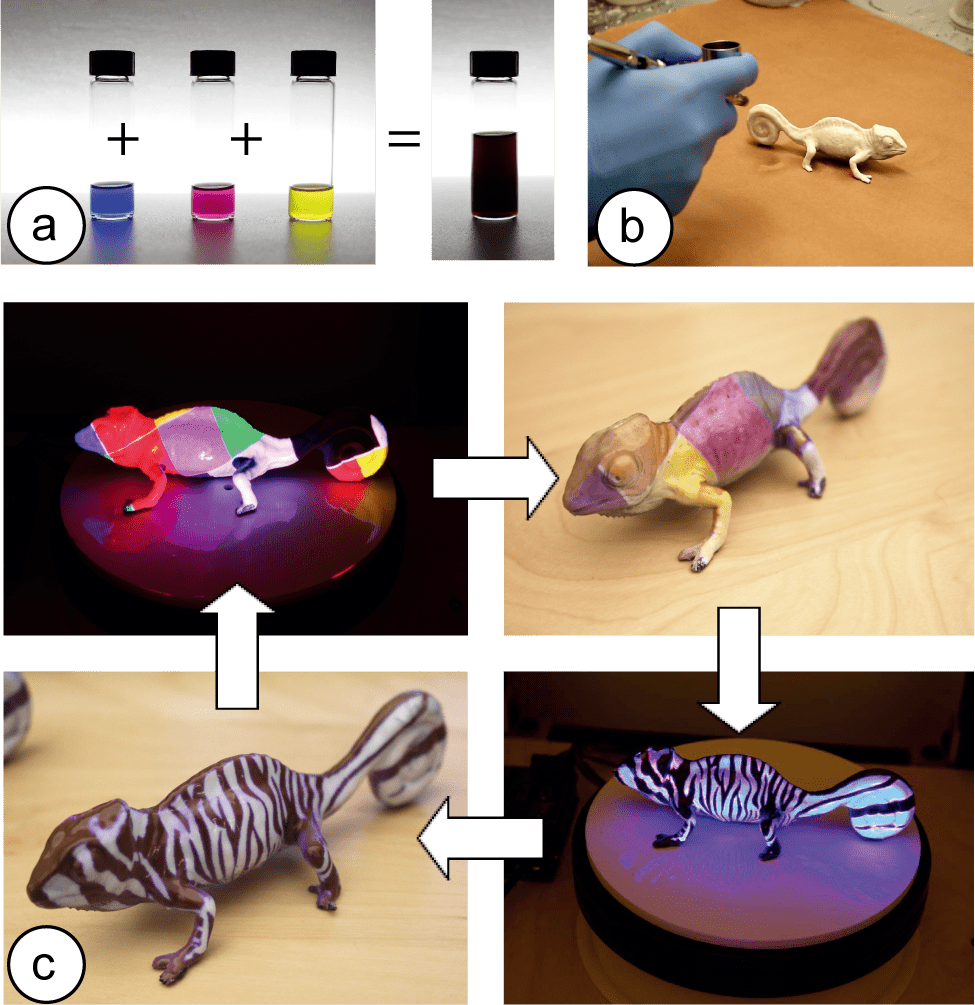If you’ve ever been envious of chameleons, rejoice! New research is bringing their color-changing properties to a dye near you.

Researchers at MIT’s Computer Science and Artificial Intelligence Laboratory (CSAIL) have designed a new, reprogrammable ink that can change color when exposed to ultraviolet (UV) and visible light sources. Dubbed “PhotoChromeleon,” the dyes can be used on anything from phone cases to cars and is resilient enough to be used in natural environments without rubbing off.
Color, changed
“This special type of dye could enable a whole myriad of customization options that could improve manufacturing efficiency and reduce overall waste,” says CSAIL postdoc Yuhua Jin, the lead author of the new study.
“Users could personalize their belongings and appearance on a daily basis, without the need to buy the same object multiple times in different colors and styles.”
PhotoChromeleon dyes are a mix of photochromic dyes that can be sprayed or painted onto the surface of any object to change its color. The process is fully reversible and can be repeated infinitely, the team explains.
The dye comes as a further development of the team’s previous “ ColorMod,” a process that involves the use of 3-D printers to fabricate items that can shift their color. PhotoChromeleon comes to address several of the limitations of ColorMod that the authors weren’t very happy with — namely, it’s limited color scheme and low-resolution results.
ColorMod relies on individually-printed 3-D pixels, and there’s a limit to how small they can be built. Overall, this makes the resolution of the finished product feel a bit grainy. As far as the colors are concerned, these pixels can only shift between two states, one showing its original color, and a transparent one. Again, cool, but not as cool as it could be.
The team’s work definitely paid off, however. They explain that PhotoChromeleon ink can be used to create anything from a landscape to zebra patterns to a flame pattern using a larger palette of colors.
PhotoChromeleon is made by mixing cyan, magenta, and yellow (CMY) photochromic dyes (i.e. dyes that change color when exposed to light) into a sprayable solution. By understanding how each dye interacts with different wavelengths, the team can control each color channel by activating and deactivating them with the corresponding light sources.
More specifically, they use three different types of light with different wavelengths to ‘eliminate’ each of the primary colors. For example, blasting the dyes with blue light would inactivate the yellow color (it’s chromatic opposite), leaving only magenta and cyan which gives an overall blue appearance. Blast it with a green light and it would turn blue (by inactivating the magenta dye).
“By giving users the autonomy to individualize their items, countless resources could be preserved, and the opportunities to creatively change your favorite possessions are boundless,” says MIT Professor Stefanie Mueller.
Using the dyes is as simple as spraying it over an object, then placing it in a box with a projector and UV light. The UV light first ‘saturates’ the dyes, turning them from transparent to visible, and the projector ‘desaturates’ them as needed (this produces the final color or color patterns). To reset the whole lot, all you have to do is blast it again with UV light and start over.
In order to help you get the exact finish you want, the team also developed a user interface to process designed and patterns for projection onto the desired items. Users can upload a blueprint and the program handles mapping (i.e. bending and applying it) onto the object.
As proof-of-concept tests, the team used their dye on a car model, a phone case, a shoe, and (quite fittingly) a small toy chameleon. Depending on the shape and orientation of the object, the process took between 15 to 40 minutes, the patterns all had high resolutions and could be successfully erased when desired.
While PhotoChromeleon is definitely more capable than its predecessor, it’s not perfect. The team didn’t have access to photochromic dyes that perfectly match magenta or cyan, so they used close approximations. In the future, they plan to collaborate with materials scientists to improve their dyes.
The paper “Photo-Chromeleon: Re-Programmable Multi-Color Textures Using Photochromic Dyes” has been published in the Proceedings of UIST 2019.









